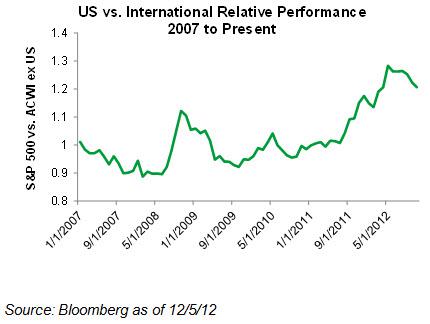With both the fiscal cliff and debt ceiling looming, US stocks beginning to trail stocks overseas and the much increased volatility of the U.S. market compared to those outside the U. S., it is getting difficult to argue that the U.S. is still the “safe port” in a storm. Given the changing dynamic, we continue to believe that this is a good time for investors to consider lowering their overweight position in US equities while raising the allocation to international stocks. [I explain my position more fully in this article.] Words: 707
stocks overseas and the much increased volatility of the U.S. market compared to those outside the U. S., it is getting difficult to argue that the U.S. is still the “safe port” in a storm. Given the changing dynamic, we continue to believe that this is a good time for investors to consider lowering their overweight position in US equities while raising the allocation to international stocks. [I explain my position more fully in this article.] Words: 707
So writes Russ Koesterich (http://isharesblog.com/blog/) in edited excerpts from his original article* entitled The Cost Of Viewing The U.S. As A ‘Safe’ Haven.
This article is presented compliments of www.munKNEE.com (Your Key to Making Money!) and may have been edited ([ ]), abridged (…) and/or reformatted (some sub-titles and bold/italics emphases) for the sake of clarity and brevity to ensure a fast and easy read. The author’s views and conclusions are unaltered and no personal comments have been included to maintain the integrity of the original article. Please note that this paragraph must be included in any article re-posting to avoid copyright infringement.
Koesterich goes on to say, in part:
There were reasonable arguments for keeping your money [invested] in the United States over the past five years [even as] the United States endured a brutal recession and is still suffering through an anemic recovery as, on a relative basis, the economy has been a bright spot, particularly compared to Europe and Japan. Since the end of the recession corporations have churned out record profits, the dollar has been stable, and interest rates remain near historic lows.
In the past few years, having a strong US focus has been a good trade. Since exiting the recession in mid-2009, US stocks have significantly outperformed international markets but this trend is starting to break [as can be seen in the chart below].

The Return Opportunity of Investing Internationally
Since the summer, US stocks have trailed stocks overseas. In the three months between the end of August and the end of November, US stocks gained less than 1% as measured by the S&P 500 versus a 5.5% advance for the MSCI ACWI-ex US Index. I believe this trend is likely to continue.
While US stocks still appear reasonably priced, and downright cheap compared to fixed-income alternatives, they are relatively expensive compared with other countries.
- US large caps trade for 2.1 times book value compared with 1.45 for the rest of the world. This represents a 47% premium, which is well above the five-year average.
- US stocks look particularly pricey compared to Europe, which has a price-to-book ratio of 1.16; Japan with a P/B ratio of 0.96, and emerging markets with a P/B ratio of 1.56.
Some of the [above mentioned] premium is justified. As I mentioned, US companies maintain near-record profitability. Assuming the fiscal cliff is avoided, the United States is almost certain to grow significantly faster in 2013 than either Europe or Japan but with the fiscal cliff looming, the size of the premium is becoming harder to rationalize.
Should the full brunt of the fiscal cliff hit and remain in place, a prolonged period of fiscal tightening would dramatically alter the U.S. growth picture. The United States would likely go from an environment of 2% growth to a modest recession. Under this scenario, Japan and perhaps even Europe are likely to grow faster in 2013.
Even if most of the fiscal cliff can be avoided, the United States is still likely to experience some fiscal drag in 2013, probably on the order of magnitude of 1% to 2%. For an economy only growing by 2%, this will represent a significant headwind and will lower the differential between US growth and other developed countries.
Beyond the fiscal cliff, the current value differential between the United States and emerging markets appears particularly rich. We are cautiously optimistic that emerging market countries will re-accelerate in 2013. While they are unlikely to match the glory days of 2010, lower relative valuations and faster growth suggest that this is a good time to overweight this asset class.
The Risk Argument for Investing Internationally
Since 2010, stock market risk – measured using the volatility of daily returns – was roughly equal in and outside the United States. Since November 1 that has changed. Over the past five weeks, the volatility of the US market has been roughly 30% higher than the volatility of markets outside the United States.
Conclusion
With both the fiscal cliff and debt ceiling looming, it is getting difficult to argue that the United States is still the “safe port” in a storm. Given the changing dynamic, we continue to believe that this is a good time for investors to consider lowering their overweight position in US equities while raising the allocation to international stocks.
Sign up HERE to receive munKNEE.com’s unique newsletter, Your Daily Intelligence Report
- FREE
- The “best of the best” financial, economic and investment articles to be found on the internet
- In an “edited excerpts” format to provide brevity & clarity to ensure a fast & easy read
- Don’t waste time searching for articles worth reading. We do it for you!
- Sign up HERE and begin receiving your newsletter starting tomorrow
- You can also follow the “munKNEE” on Facebook
*http://isharesblog.com/blog/2012/12/15/the-cost-of-viewing-the-us-as-a-%e2%80%9csafe%e2%80%9d-haven/
Related Articles:
The U.S. has reached a Debt to GDP ratio of over 100%. Indeed, at no point in history has the U.S. had this much debt during peacetime – and the fact that we’re overspending by this amount at the exact time that other countries are showing signs of shunning US Treasuries is a formula for disaster. With that in mind, it is highly likely that the U.S. will enter at the very minimum a debt crisis and quite possibly a currency crisis during the Obama administration’s second term. [Such being the case,] now, more than ever, investors need to get access to high quality guidance and insights [and this article does just that] to help you navigate the markets and protect your wealth. Words: 964
2. Investors, Get Fully Invested! S&P 500 On Verge of Entering Euphoria Stage of Cyclical Bull Market
[In spite of all that is seemingly wrong with the U.S. economy] I think we are on the verge of entering the euphoria stage of this cyclical bull market where traders become convinced that QE3 is a magic elexir with no unintended consequesnces. [As such,] I see a strong acceleration and a significant and sustained breakout above the S&P 500 September high of 1475. (Words: 264 + 3 charts)
3. It’s Time to Get “All In”! Here’s Why
The last couple of weeks have offered such amazing buying opportunities that I’m now “all in” and suggest you follow suit, immediately. In 2-6 months you can thank me and send me photos of the vacation you bought with the extra money. Words: 508
Savers will not stand idly by and watch their savings get wiped out by taxes and inflation….[which] is good news for investors who buy and hold commodity assets today – and it’s also a stark reminder to not be fooled by the short-term head fakes that might make it look like the commodity bull is over. Stay the course – the biggest profits are yet to come. [Here’s why.] Words: 405
 munKNEE.com Your Key to Making Money
munKNEE.com Your Key to Making Money


